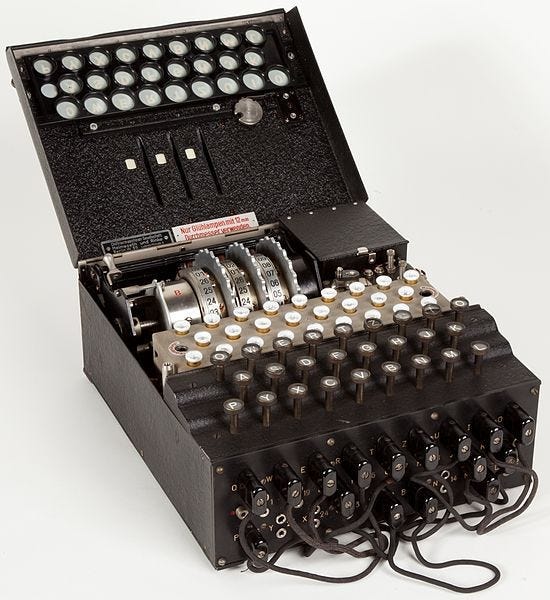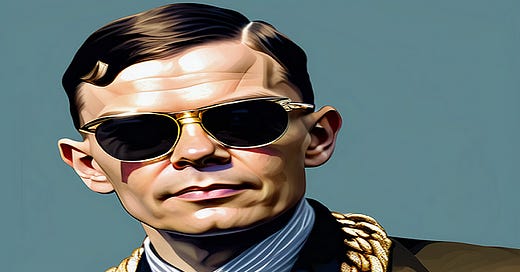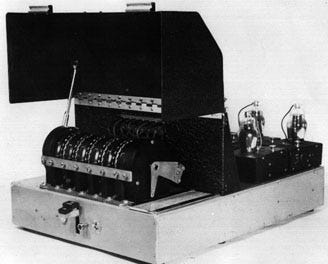The Connection Between Alan Turing, Modern Music, And WWII Spy Tech
What do pop musicians’ vocals and the WWII Allied Powers have in common?
You’ve recently missed something interesting. How do I know this? Because I missed it along with you since the event occurred at an auction house on November 14, 2023.
While auctions usually involve boring antiques that sit on shelves collecting dust, this one at Bonhams in London had a weird item that sent me down one of those rabbit holes you’d never expect.
This lot was a series of papers written by mathematician Alan Turing. I’m sure you recognize his name for many reasons.
But if you’re not familiar, he was a British genius who was a driving force in breaking the Enigma code machines used by the Germans in WWII, a pioneer in early computers, and his name is given to a test that measures artificial intelligence capabilities.
The papers sold for £381,400 and were marked as part of “The Delilah Project.” By now, I’m sure Turing’s name, the weird project title, and the high price have piqued your curiosity.
So, what was the Delilah Project?

Well, right now, it’s a bridge between the height of World War II spy tech, and the glitz and glamor of modern pop music. In fact, I can guarantee you’ve heard songs using derivatives of the technology.
As I hinted, it’s a strange journey with connections almost too weird to place together. But we need a starting point. This occurred on Alan Turing's epic trip across the Atlantic in November 1942.
A Trip Across The Ocean And A Wall Of Secrecy
The Turing Guide by Jack Copeland et al. explains crossing the Atlantic at the end of November 1942 wasn’t something for the faint of heart. Not only are the waters rough, but a hundred ships were destroyed by U-boats on the same crossing that very year.
Turing found himself the only civilian on a passenger liner that functioned as a “floating barracks.” The ship was so overloaded with military bodies that Turing admitted to nearly passing out due to the claustrophobic, cramped conditions.
You might wonder why a valuable asset to Britain would be placed in such dangerous conditions. He’d just been a major player in cracking the Enigma encryption devices used by the German Air Force and Navy, so a boat trip across U-boat-infested waters sounded foolish.
Copeland and his associates explain that the Allies were interested in codebreaking and encrypting their communications against spying. Turing’s destination was Bell Labs in New York City, where a pioneering technology showed promise to do just that.
However, the Brit’s trip experienced complications.
First, his paperwork wasn’t deemed acceptable to get off Ellis Island, and he was almost imprisoned until things were fixed. Once released, he wasn’t allowed in Bell Labs by the US Chief of Staff for the Army, Gen. George Marshall, because of secrecy.
While Churchill’s representative in the United States intervened, Turing spent a few months helping US code breakers improve their skills. The Brit must have been both angry and curious about Bell Labs. But in January 1943, the thirteen-story laboratory opened its doors to the traveler.
Bell Labs, The Vocoder, And Voice Encryption
“Bell Labs was developing a speech encryption system based on a voice synthesizer called the ‘vocoder.’ Speech encryption was cryptology’s new frontier. If speech could be encrypted securely, then top-level secret business could be conducted person to person, by radio, or even by telephone…”
— The Turing Guide, Jack Copeland et al
While Turing spent his time codebreaking at England’s Bletchley Park, the cryptologists at Bell Labs were encrypting messages. Moreover, they evolved from written text. Their technology was making the spoken word more secure.

The Americans created a massive SIGSALY system, a digital speech encryption system, which looked like something out of an old sci-fi movie. Copeland and his colleagues say the machine occupied three sides of a room and stood taller than Turing. It was immense in size, price, and intricacy.
The Imperial War Museum says each machine weighed fifty tons and cost a million dollars in 1943. It digitized a speaker's voice and mixed this signal with random noise. That’s all any eavesdropper would hear listening to a SIGSALY message: random noise.
You needed a SIGSALY on each end to make sense of the transmission. One used a vocoder to synthesize the voice and another to reconfigure it. The random noises came from a spinning record on a turntable. Each machine played the same record in sync, functioning as a key to encrypt and decrypt the signal.
The voices received could sound robotic, but it functioned otherwise.
Only twelve systems were created, used, and placed in strategic places worldwide, such as Washington DC, London, Algiers, Australia, and the Philippines from 1943 to 1946. Turing spent a few months witnessing this early technology at Bell Labs.
While it’s unknown if Turing helped improve this machine during his stay, when he returned to England, he understood how it worked and had an idea of how to build his own.
Turing Shrinks The Technology With Delilah
When Turing returned home, he set up an electronics lab a few miles from the codebreaking center of Bletchley Park and worked with a few other electronics wizards to create a smaller version of SIGSALY. They eventually made a functional machine the size of three small shoe boxes.
This “Delilah” device first “discretized” the speech by turning it into a group of numbers, each representing the voltage of the voice signal for an instance of time. Then, the machine added an “obscuring key” to the numbers, which created an encrypted version of the voice statement. This jumble of numbers was transmitted to another Delilah machine.
When both machines were synched with the same key, the receiving machine removed this obscuring key and turned the numbers back into the specific voltage for the voice signal. This produced a cracking but understandable reproduction of the original voice message.

Copeland says the secret to the encryption and decryption was a “five-wheeled text-enciphering machine modeled on” something Turing was familiar with — the German Enigma device.
The papers auctioned at Bonhams are Turing’s written notes detailing the theory behind how Delilah functioned. Unfortunately, the device came a bit late. Germany had collapsed by the time it was ready in May of 1945. So, it was forgotten.
Although the idea of a Delilah-like smaller vocoder would reemerge later.
The Vocoder Finds A New Purpose
While the military developed new vocoder versions, another industry found a different purpose. The music industry realized you could mix the tonal qualities of an instrument with the articulation of a human voice to create a new sound mixture.
Like the original vocoder, the result has a robotic-like quality, but placing it within music created something unique.
NPR notes musician Wendy Carlos used this technology to create the soundtrack for A Clockwork Orange in 1971, then made an award-winning album consisting of an electronic reproduction of the fourth movement of Beethoven’s Ninth Symphony.
While it was still expensive, more vocoders started popping up in music studios. A German electric pop group called Kraftwerk created a single named The Robots in 1978, and by the 80s, this futuristic sound found traction in the Hip-Hop community.
Afrika Bambaataa landed a smash hit with Planet Rock, and Newcleus released Jam On It; both songs prominently featured the vocoder. In more recent years, you can hear it in the beginning of the Beastie Boys Intergalactic, and artists like T-Pain, Snoop Dog, Lil Wayne, and Kanye West have mixed it into their songs.
As I mentioned, it’s one of those bizarre rabbit holes that takes you from an auction house with Alan Turing’s papers in 2023 England, back across the Atlantic in WWII, then back to England again, and finally to the modern-day world of pop music.
This series of leaps shows you exactly how exciting history can be. Moreover, it poses and answers one of the strangest riddles you’ll ever encounter.
What do pop musicians’ vocals and the WWII Allied Powers have in common?
The vocoder.
-Originally posted on Medium 1/8/24




